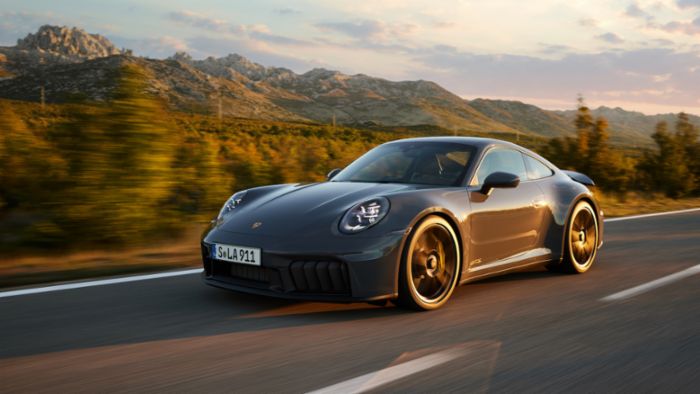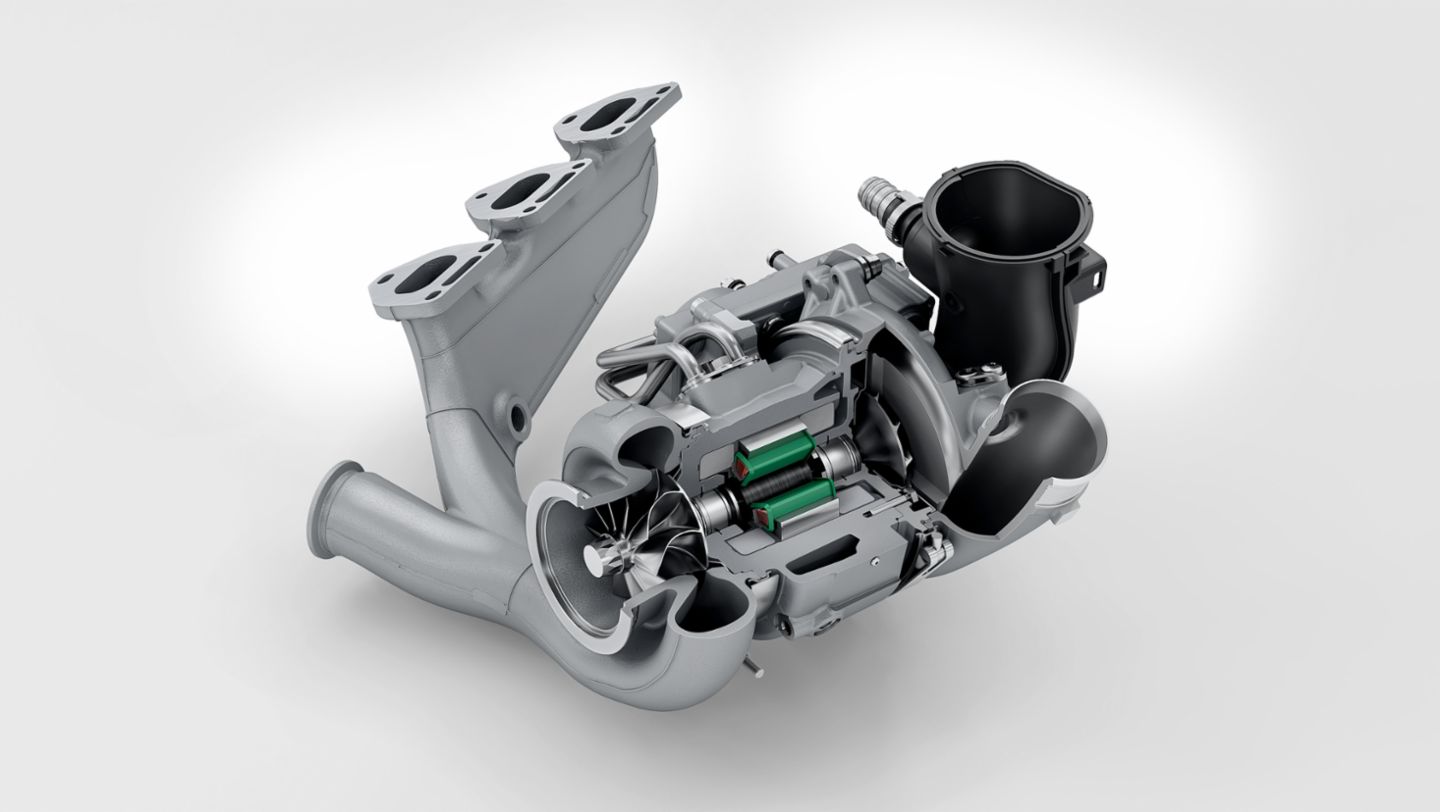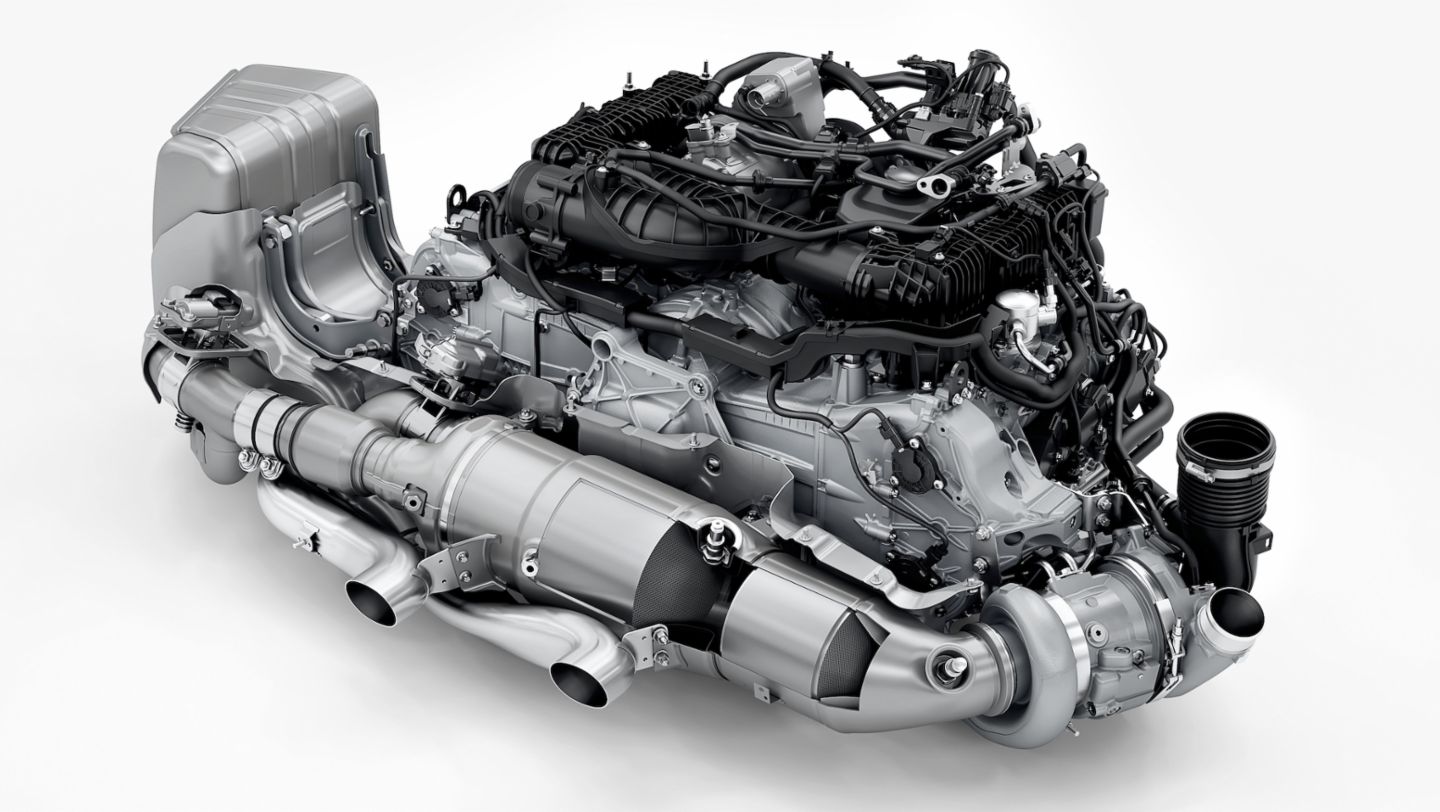The newly developed innovative drive system with a displacement of 3.6 liters (911 Carrera GTS (preliminary values): Fuel consumption* combined (WLTP) 11.0 – 10.5 l/100 km, CO₂ emissions* combined (WLTP) 251 – 239 g/km, CO2 class G ), provides significantly improved driving characteristics. The 911 Carrera GTS Coupé accelerates from zero to 100 km/h in 3.0 seconds and reaches a top speed of 312 km/h. The 911 Carrera will also be available immediately after the launch of the new model. It is powered by a slightly modified 3.0-litre twin-turbo boxer engine (911 Carrera: Fuel consumption* combined (WLTP) 10.7 – 10.1 l/100 km, CO₂ emissions* combined (WLTP) 244 – 230 g/km, CO2 class G), which is more powerful than its predecessor. The new 911 also features a refreshed design, better aerodynamics, a fresh interior, improved standard equipment and expanded connectivity.
With the relaunch of its iconic model, Porsche has modernized four of its six model lines in just a few months: Panamera, Taycan, Macan and 911. “Our product portfolio is younger than ever and extremely attractive,” says CEO Oliver Blume. “It offers our customers even more customization options and exceptional experiences.”
Inspired by motorsports: an innovative dynamic hybrid
For the new 911 Carrera GTS models, Porsche engineers used the knowledge gained from motor racing as a basis for designing the hybrid system. “We developed and tested a wide variety of ideas and approaches to arrive at the hybrid system that would fit the 911 perfectly. The result is a unique drive that fits into the overall concept of the 911 and significantly improves its performance,” says Frank Moser, vice president of the 911 and 718 model lines.
The light and powerful T-Hybrid system has a newly developed electric turbocharger for the exhaust gases. An integrated electric motor placed between the compressor wheel and the turbine instantly accelerates the turbocharger. This immediately creates a build-up pressure. The electric motor in the exhaust gas turbocharger also functions as a generator. It generates up to 11 kW (15 PS) of electrical power. This energy is extracted from the exhaust gas flow. The wastegate-free electric turbocharger allows the use of only one turbocharger instead of the previous two, which ensures a more dynamic and responsive power delivery.
The drivetrain also includes a permanent magnet synchronous motor integrated into the new, more powerful eight-speed dual clutch (PDK) transmission. Even at idle speed, it supports the boxer engine with an additional drive torque of up to 150 Nm and provides a power increase of up to 40 kW. Porsche connects the two electric motors with a light and compact high-voltage battery. It corresponds in size and weight to a conventional 12-volt starter battery, but stores up to 1.9 kWh of energy (gross) and operates at a voltage of 400 V. For an optimized overall weight, Porsche installed a lightweight lithium-ion battery for the 12 V on-board electrical system .
The heart of the T-Hybrid drivetrain is the newly developed 3.6-liter boxer engine. The high voltage system allows the A/C compressor to be driven electrically and as a result eliminate the belt drive, making the engine much more compact. This creates space above the power supply unit for the pulse inverter and DC-DC converter. An enlarged bore of 97 mm and an increased stroke of 81 mm increase displacement by 0.6 liters compared to its predecessor. The engine has VarioCam camshaft control and rocker valve control. It maintains the ideal fuel/air mixture ratio across the map (lambda = 1).
Even without electric assistance, the boxer engine delivers 357 kW (485 hp) and 570 Nm of torque. The total output of the system is 398 kW (541 PS) and 610 Nm. The power increase compared to the predecessor is 45 kW (61 PS). The new 911 Carrera GTS also beats its predecessor in the sprint to 100 km/h, especially off the line. The efficient performance hybrid achieves extremely dynamic driving characteristics while reducing CO₂ emissions with significantly less additional weight than plug-in hybrid vehicles. The increase in weight compared to the predecessor is only 50 kilograms.
The 911 Carrera still features a twin-turbocharged 3.0-liter boxer engine. This engine has also been completely rebuilt. Among other things, it has now adopted the intercooler from the Turbo models, which is now located directly under the tailgate grille, above the engine. The turbochargers in the new 911 Carrera were reserved for the GTS models in its predecessor. With these modifications, Porsche simultaneously achieves a reduction in emissions and an increase in power to 290 kW (394 hp), along with a maximum torque of 450 Nm. The new 911 Carrera Coupé accelerates from 0 to 100 km/h in 4.1 seconds (3.9 seconds with the Sport Chrono package) and boasts a top speed of 294 km/h. Compared to its predecessor, this represents an improvement of 0.1 seconds and 1 km/h respectively.
Optimized suspension and active aerodynamics
The suspension of the 911 Carrera GTS has also been completely revised. For the first time, rear axle steering is now standard. Increases stability at high speeds and reduces turning diameter. Porsche has integrated the anti-roll stabilization system Porsche Dynamic Chassis Control (PDCC) into the high-voltage system of the powerful hybrid. This allows the use of an electro-hydraulic control system, making the system even more flexible and precise. The sports suspension with variable damping system (PASM) and ground clearance reduced by 10 mm provide characteristic GTS handling.
A total of seven 19-/20-inch or 20-/21-inch wheel designs are available for the new 911. Available for the first time in the 911 Carrera are wheels of an exclusive design with carbon lamellae, which reduce the drag coefficient and therefore increase efficiency. 911 Carrera GTS models ride on 21-inch wheels that are 11.5 inches wide and 315/30 ZR 21 tires at the rear as standard. Up front are 245/35 ZR 20 tires on 20-inch wheels that are 8.5 inches wide. In line with the significantly improved performance, the wider footprint of the rear tires improves the driving dynamics and grip of the new 911 Carrera GTS.
Sporty, clean exterior
Porsche has streamlined the 911’s exterior design with carefully targeted updates. Most of these measures improve the aerodynamics and performance of the sports car. Changes include new model-specific bumpers. For the first time, Porsche has also integrated all the lighting functions into the already standard matrix LED headlights of the 911, with their characteristic four-point graphics. This allows the headlights to be omitted and makes room for larger cooling vents at the front of the car.
On 911 Carrera GTS models, the front has five vertically positioned active cooling air flaps visible from the outside, and another hidden flap on each side. For the first time in a 911, these are complemented by adaptive front diffusers at the bottom, which are controlled together with the cooling air flaps. These elements direct the airflow as needed: when power requirements are minimal, closed flaps optimize aerodynamics. When power demand is high – for example in track situations – the flaps direct large amounts of air to the car’s radiators. The sensors for the assistance systems are now located behind a glossy surface below the license plate.
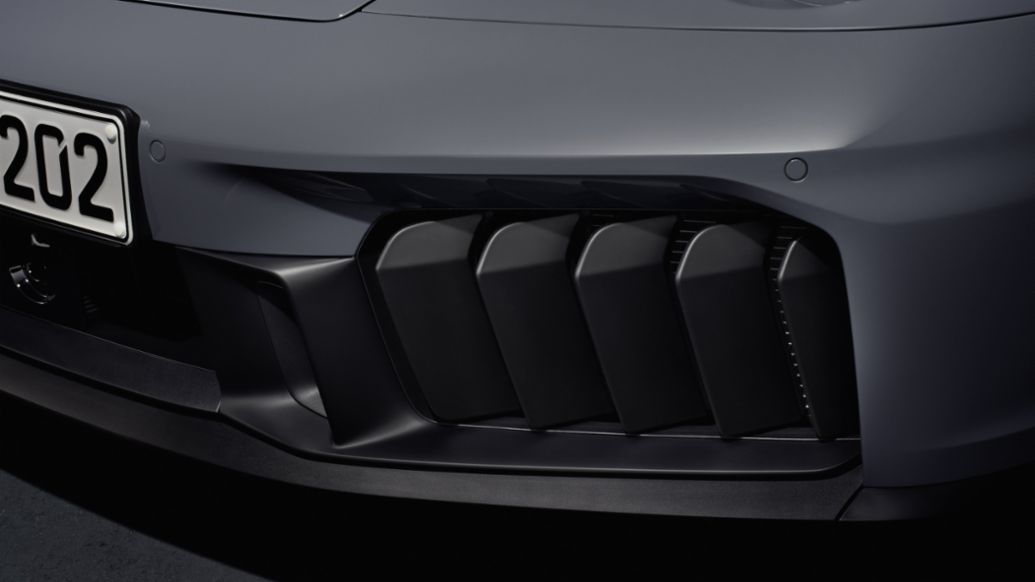
As an option, Porsche offers the new headlights with an HD matrix LED function with more than 32,000 light points. High-efficiency high beams illuminate the road at a distance of more than 600 meters. It also offers innovative additional features such as driving mode-dependent dynamic cornering lights, lane lighting, construction site and narrow spot lights and anti-dazzle high beams that are pixel-precise.
The redesigned light bar with integrated arc and “PORSCHE” logo makes the rear of the 911 appear deeper and wider. A redesigned rear grille with five fins on each side joins the rear glass to form a graphic unit that fades into the retractable spoiler below. The number is positioned higher, with a clearly structured rear bumper. The model-specific exhaust systems are elegantly integrated into the striking diffuser fins. A sports exhaust system is available as an option for 911 Carrera models. 911 Carrera GTS models come standard with a GTS-specific sports exhaust system.
The optional aviation kit further enhances the performance of the 911 Coupé. It features a distinctive SportDesign front bumper with a unique front spoiler, matching side sill panels and a lighter, fixed rear wing. These components reduce lift and improve the sports car’s grip.
Fully digital cockpit and advanced connectivity
In the coupe variants, Porsche has designed the interior of the new 911 as a standard two-seater. A 2+2 seat configuration is available as an option at no extra charge. In the cockpit, Porsche combines the familiar design DNA of the 911 with modern technology: the Porsche Driver Experience control concept focuses on the driver’s axis and intuitive, faster operation. The main controls are located directly on or around the steering wheel. These include the standard drive mode switch, the redesigned driver assist lever and, for the first time in a 911, a start button – to the left of the steering wheel, naturally. In the center console storage compartment of the new 911, there is a cooled compartment for smartphones with an inductive charging function.
For the first time, a 911 has a fully digital instrument cluster. The 12.6-inch curved display fits elegantly into the new control and display concept and can be widely customized. It offers up to seven views, including an exclusive classic display inspired by the traditional Porsche dial design with five pipes and a central tachometer.
The Porsche Communication Management (PCM) system is still controlled via a high-resolution central display with a 10.9-inch screen. However, the options for personalizing the driving modes and the operation of the driver assistance systems have been significantly improved. The facelifted 911 also has new connectivity features. The QR code greatly simplifies the process of entering the PCM with the Porsche ID. Apple CarPlay® is more deeply integrated into the car. If desired, it displays information on the dashboard and allows the control of the car’s functions directly in the Apple® ecosystem, for example via the Siri® voice assistant. For the first time, video streaming is also optionally available when parking. Apps like Spotify® and Apple Music® can be used as native apps in PCM without a connected smartphone.
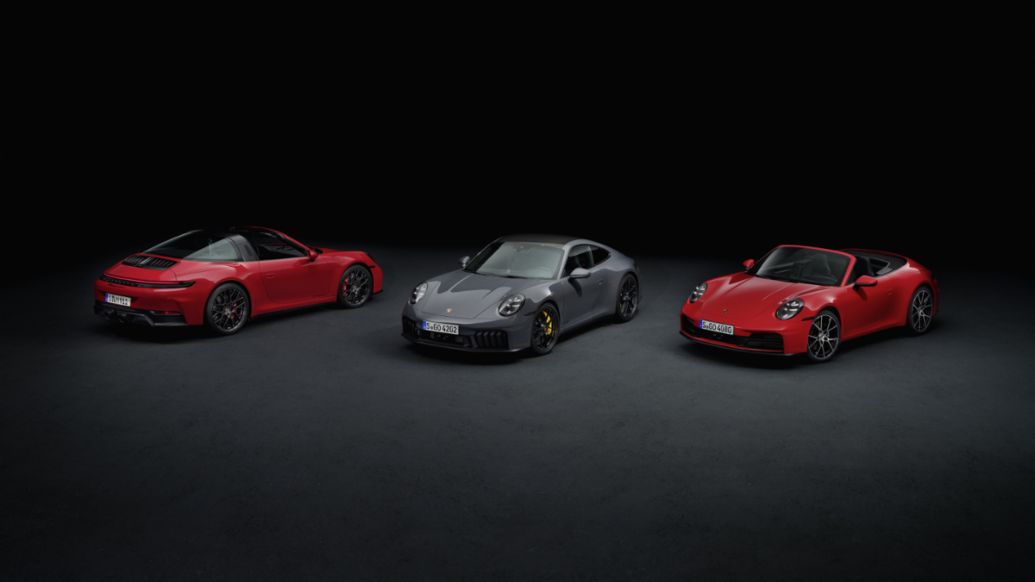
Now available to order
The new 911 Carrera can be ordered now as a rear-wheel drive coupé and convertible. All-wheel drive and a Targa body variant (exclusively available with all-wheel drive) are also available for the 911 Carrera GTS. Both model variants are equipped with Porsche Doppelkupplung (PDK) as standard.
